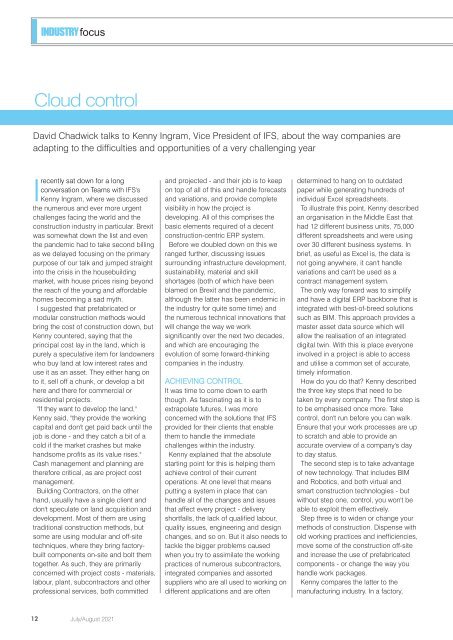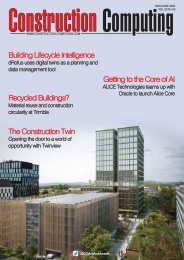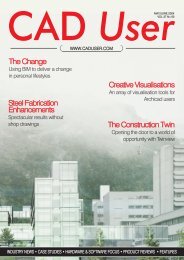Create successful ePaper yourself
Turn your PDF publications into a flip-book with our unique Google optimized e-Paper software.
INDUSTRY focus<br />
Cloud control<br />
David Chadwick talks to Kenny Ingram, Vice President of IFS, about the way companies are<br />
adapting to the difficulties and opportunities of a very challenging year<br />
Irecently sat down for a long<br />
conversation on Teams with IFS's<br />
Kenny Ingram, where we discussed<br />
the numerous and ever more urgent<br />
challenges facing the world and the<br />
construction industry in particular. Brexit<br />
was somewhat down the list and even<br />
the pandemic had to take second billing<br />
as we delayed focusing on the primary<br />
purpose of our talk and jumped straight<br />
into the crisis in the housebuilding<br />
market, with house prices rising beyond<br />
the reach of the young and affordable<br />
homes becoming a sad myth.<br />
I suggested that prefabricated or<br />
modular construction methods would<br />
bring the cost of construction down, but<br />
Kenny countered, saying that the<br />
principal cost lay in the land, which is<br />
purely a speculative item for landowners<br />
who buy land at low interest rates and<br />
use it as an asset. They either hang on<br />
to it, sell off a chunk, or develop a bit<br />
here and there for commercial or<br />
residential projects.<br />
"If they want to develop the land,"<br />
Kenny said, "they provide the working<br />
capital and don't get paid back until the<br />
job is done - and they catch a bit of a<br />
cold if the market crashes but make<br />
handsome profits as its value rises."<br />
Cash management and planning are<br />
therefore critical, as are project cost<br />
management.<br />
Building Contractors, on the other<br />
hand, usually have a single client and<br />
don't speculate on land acquisition and<br />
development. Most of them are using<br />
traditional construction methods, but<br />
some are using modular and off-site<br />
techniques, where they bring factorybuilt<br />
components on-site and bolt them<br />
together. As such, they are primarily<br />
concerned with project costs - materials,<br />
labour, plant, subcontractors and other<br />
professional services, both committed<br />
and projected - and their job is to keep<br />
on top of all of this and handle forecasts<br />
and variations, and provide complete<br />
visibility in how the project is<br />
developing. All of this comprises the<br />
basic elements required of a decent<br />
construction-centric ERP system.<br />
Before we doubled down on this we<br />
ranged further, discussing issues<br />
surrounding infrastructure development,<br />
sustainability, material and skill<br />
shortages (both of which have been<br />
blamed on Brexit and the pandemic,<br />
although the latter has been endemic in<br />
the industry for quite some time) and<br />
the numerous technical innovations that<br />
will change the way we work<br />
significantly over the next two decades,<br />
and which are encouraging the<br />
evolution of some forward-thinking<br />
companies in the industry.<br />
ACHIEVING CONTROL<br />
It was time to come down to earth<br />
though. As fascinating as it is to<br />
extrapolate futures, I was more<br />
concerned with the solutions that IFS<br />
provided for their clients that enable<br />
them to handle the immediate<br />
challenges within the industry.<br />
Kenny explained that the absolute<br />
starting point for this is helping them<br />
achieve control of their current<br />
operations. At one level that means<br />
putting a system in place that can<br />
handle all of the changes and issues<br />
that affect every project - delivery<br />
shortfalls, the lack of qualified labour,<br />
quality issues, engineering and design<br />
changes, and so on. But it also needs to<br />
tackle the bigger problems caused<br />
when you try to assimilate the working<br />
practices of numerous subcontractors,<br />
integrated companies and assorted<br />
suppliers who are all used to working on<br />
different applications and are often<br />
determined to hang on to outdated<br />
paper while generating hundreds of<br />
individual Excel spreadsheets.<br />
To illustrate this point, Kenny described<br />
an organisation in the Middle East that<br />
had 12 different business units, 75,000<br />
different spreadsheets and were using<br />
over 30 different business systems. In<br />
brief, as useful as Excel is, the data is<br />
not going anywhere, it can't handle<br />
variations and can't be used as a<br />
contract management system.<br />
The only way forward was to simplify<br />
and have a digital ERP backbone that is<br />
integrated with best-of-breed solutions<br />
such as BIM. This approach provides a<br />
master asset data source which will<br />
allow the realisation of an integrated<br />
digital twin. With this is place everyone<br />
involved in a project is able to access<br />
and utilise a common set of accurate,<br />
timely information.<br />
How do you do that? Kenny described<br />
the three key steps that need to be<br />
taken by every company. The first step is<br />
to be emphasised once more. Take<br />
control, don't run before you can walk.<br />
Ensure that your work processes are up<br />
to scratch and able to provide an<br />
accurate overview of a company's day<br />
to day status.<br />
The second step is to take advantage<br />
of new technology. That includes BIM<br />
and Robotics, and both virtual and<br />
smart construction technologies - but<br />
without step one, control, you won't be<br />
able to exploit them effectively.<br />
Step three is to widen or change your<br />
methods of construction. Dispense with<br />
old working practices and inefficiencies,<br />
move some of the construction off-site<br />
and increase the use of prefabricated<br />
components - or change the way you<br />
handle work packages.<br />
Kenny compares the latter to the<br />
manufacturing industry. In a factory,<br />
12<br />
<strong>Jul</strong>y/<strong>Aug</strong>ust <strong>2021</strong>

















